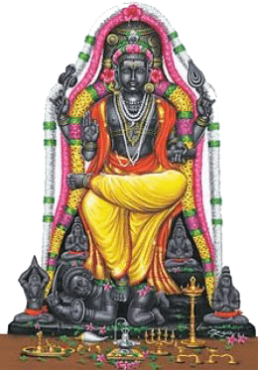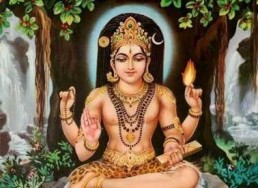Guru Ashtakam
यशश्चारु चित्रं धनं मेरुतुल्यम् ।
मनश्चेन्न लग्नं गुरोरङ्घ्रिपद्मे ।
ततः किं ततः किं ततः किं ततः किम् ॥ १ ॥
yaśaścāru citraṁ dhanaṁ mērutulyam |
manaścēnna lagnaṁ gurōraṅghripadmē |
tataḥ kiṁ tataḥ kiṁ tataḥ kiṁ tataḥ kim || 1 ||
गृहं बान्धवाः सर्वमेतद्धि जातम् ।
मनश्चेन्न लग्नं गुरोरङ्घ्रिपद्मे ।
ततः किं ततः किं ततः किं ततः किम् ॥ २ ॥
gr̥haṁ bāndhavāḥ sarvamētaddhi jātam |
manaścēnna lagnaṁ gurōraṅghripadmē |
tataḥ kiṁ tataḥ kiṁ tataḥ kiṁ tataḥ kim || 2 ||
कवित्वादि गद्यं सुपद्यं करोति ।
मनश्चेन्न लग्नं गुरोरङ्घ्रिपद्मे ।
ततः किं ततः किं ततः किं ततः किम् ॥ ३ ॥
kavitvādi gadyaṁ supadyaṁ karōti |
manaścēnna lagnaṁ gurōraṅghripadmē |
tataḥ kiṁ tataḥ kiṁ tataḥ kiṁ tataḥ kim || 3 ||
सदाचारवृत्तेषु मत्तो न चान्यः ।
मनश्चेन्न लग्नं गुरोरङ्घ्रिपद्मे ।
ततः किं ततः किं ततः किं ततः किम् ॥ ४ ॥
sadācāravr̥ttēṣu mattō na cānyaḥ |
manaścēnna lagnaṁ gurōraṅghripadmē |
tataḥ kiṁ tataḥ kiṁ tataḥ kiṁ tataḥ kim || 4 |
सदा सेवितं यस्य पादारविन्दम् ।
मनश्चेन्न लग्नं गुरोरङ्घ्रिपद्मे ।
ततः किं ततः किं ततः किं ततः किम् ॥ ५ ॥
sadā sēvitaṁ yasya pādāravindam |
manaścēnna lagnaṁ gurōraṅghripadmē |
tataḥ kiṁ tataḥ kiṁ tataḥ kiṁ tataḥ kim || 5 ||
ज्जगद्वस्तु सर्वं करे यत्प्रसादात् ।
मनश्चेन्न लग्नं गुरोरङ्घ्रिपद्मे ।
ततः किं ततः किं ततः किं ततः किम् ॥ ६ ॥
jjagadvastu sarvaṁ karē yatprasādāt |
manaścēnna lagnaṁ gurōraṅghripadmē |
tataḥ kiṁ tataḥ kiṁ tataḥ kiṁ tataḥ kim || 6 ||
न कान्तामुखे नैव वित्तेषु चित्तम् ।
मनश्चेन्न लग्नं गुरोरङ्घ्रिपद्मे ।
ततः किं ततः किं ततः किं ततः किम् ॥ ७ ॥
na kāntāmukhē naiva vittēṣu cittam |
manaścēnna lagnaṁ gurōraṅghripadmē |
tataḥ kiṁ tataḥ kiṁ tataḥ kiṁ tataḥ kim || 7 ||
न देहे मनो वर्तते मे त्वनर्घ्ये ।
मनश्चेन्न लग्नं गुरोरङ्घ्रिपद्मे ।
ततः किं ततः किं ततः किं ततः किम् ॥ ८ ॥
na dēhē manō vartatē mē tvanarghyē |
manaścēnna lagnaṁ gurōraṅghripadmē |
tataḥ kiṁ tataḥ kiṁ tataḥ kiṁ tataḥ kim || 8 ||
यतिर्भूपतिर्ब्रह्मचारी च गेही ।
लभेद्वाञ्छितार्थं पदं ब्रह्मसञ्ज्ञं ।
गुरोरुक्तवाक्ये मनो यस्य लग्नं ॥
yatirbhūpatirbrahmacārī ca gēhī |
labhēdvāñchitārthaṁ padaṁ brahmasañjñaṁ |
gurōruktavākyē manō yasya lagnaṁ ||

Description
A popular Hindu prayer declares, “The Guru is Brahma, the Guru is Vishnu, the Guru is Shiva, the Guru is verily the Supreme Absolute itself. To that Guru, I offer my salutations.”
The composition systematically demonstrates the futility of all worldly attainments without devotion to the Guru. The first verse declares that even if one possesses physical beauty, fame, and wealth equal to Mount Meru, all is meaningless without dedication to the Guru’s lotus feet. The second verse extends this to the domestic sphere – spouse, children, grandchildren, home, and relatives – the entire framework of family life. The third verse addresses intellectual achievements, asserting that mastery of the Vedas, scriptures, and literary abilities are of no value without the Guru’s grace. The fourth verse proclaims that recognition both abroad and at home, along with unmatched moral conduct, serves no purpose. The fifth verse elevates this to the highest worldly power, declaring that even being served by kings and emperors lacks meaning. The sixth verse combines far-reaching fame through charitable acts with complete control over worldly possessions, yet maintains their insufficiency.
Interestingly, the seventh and eighth verses take a different approach. Instead of listing achievements or possessions, they speak of detachment. The seventh verse describes detachment from pleasures, yoga practices, luxuries, relationships, and wealth – yet states that even this detachment is insufficient. The eighth verse completes this theme by addressing detachment from all spheres of existence – solitary life, domestic life, worldly duties, and even the precious human body – maintaining that even such complete renunciation is purposeless without Guru-bhakti.
Each verse hammers home its message with the powerful refrain: “If the mind is not devoted to the lotus feet of the Guru, then what is the use?” repeated four times, creating a rhythmic emphasis on the central message.
The final verse (phalaśruti) promises that anyone who recites these verses with devotion – be they a renunciate, king, student, or householder – will attain both their worldly desires and the supreme state of Brahman.
Other Guru Shlokams
Guru Brahma
Guru Brahma - Known as Guru Mantra or Guru Mahamantra. The guru is Brahma (Bramha) the guru is Vishnu, the guru is Maheshwara (Siva), the guru is the Self-revealing limitless Brahman. Salutations to that revered guru. - In Sanskrit with English…
Guru Paduka Stotram
Guru Paduka Stotram is a very powerful chant that glorifies the "Padukas (Sandals) of the Guru," which are symbolically represented as "the boat to help cross the endless ocean
Guru Sishya Parampara
Guru-Sishya Parampara is the teacher-disciple lineage. Being a civilization that respects experiential knowledge, we hold high respect for the teacher of such knowledge. Below
Guru Stotram
Guru stotram is a selection of 14 verses from the Guru Geeta, found in Skanda Purana. It is a conversation between Lord Shiva & Parvati on the glory of the Guru. Gu – Darkness. Ru – Remover.
Ishvaro Guru Atmeti
Shlokams,Shiva,Dakshinamurthy,Guru,Sankara
Salutations to Lord Dakshinamurti, who is all-pervasive like space but who appears (as though) divided as Lord, Guru, and the Self.
Sada Shiva Samarambam
Salutation to the lineage starting with lord Sadasiva, with Adi Sankara in the middle and continuing up to my immediate teacher.
Samasta Jana Kalyane
I salute, Shri Chinmaya, the noble teacher, the best of the knowers of Brahman (the highest Reality), and who full of compassion, is ever engaged in the welfare of all people.
Guru Ashtakam – Guru – In Sanskrit, English Translation, Meaning, Significance and Audio.


